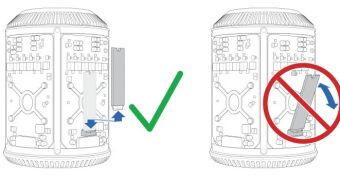After announcing the official debut of its powerful new workstation, Apple this week flooded its Support site with documentation about the computer, including two notably interesting articles which show users how to dismantle the system and upgrade it.
The Mac Pro has always been upgradable, and the Late 2013 model is no exception. In fact, thanks to its new design, the all-new Mac Pro downright invites you to pop open the hood and peek at its inner workings.
Two KB articles recently posted by Apple on its Support site reveal just how easy it is to remove the circular enclosure and access the PCIe-based flash storage and the memory DIMMs.
Both guides offer thorough instructions and detailed graphics to make it easy for everyone to carry out the task of upgrading their Mac Pro.
In both cases, users must follow Apple’s instructions with serious attention, as there is a chance of damaging the computer.
Before removing flash memory, users must make sure their data is backed up and that they are using a compatible flash storage replacement.
As far as the RAM memory is concerned, the Mac Pro (Late 2013) has four slots, each capable of supporting a 16GM memory module, for a total of 64GB of memory when all four slots are in use.
As with the storage devices, users must make sure that the replacement memory modules are compatible with the system.
“The Mac Pro supports both unbuffered UDIMMs and registered RDIMMs, but it is important not to mix these types of memory. DIMMs which are not properly installed or do not meet the system requirements may affect system performance or not be recognized by the system,” according to Apple.

 14 DAY TRIAL //
14 DAY TRIAL //